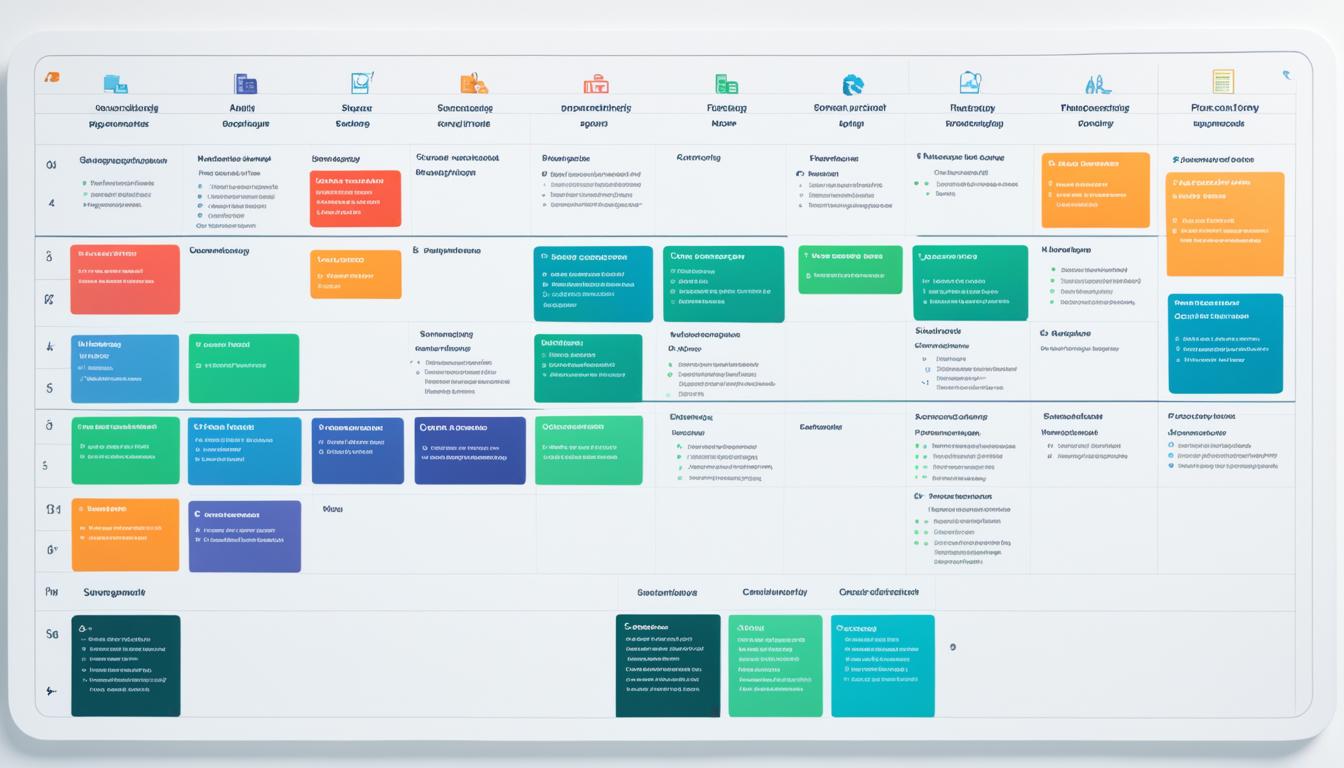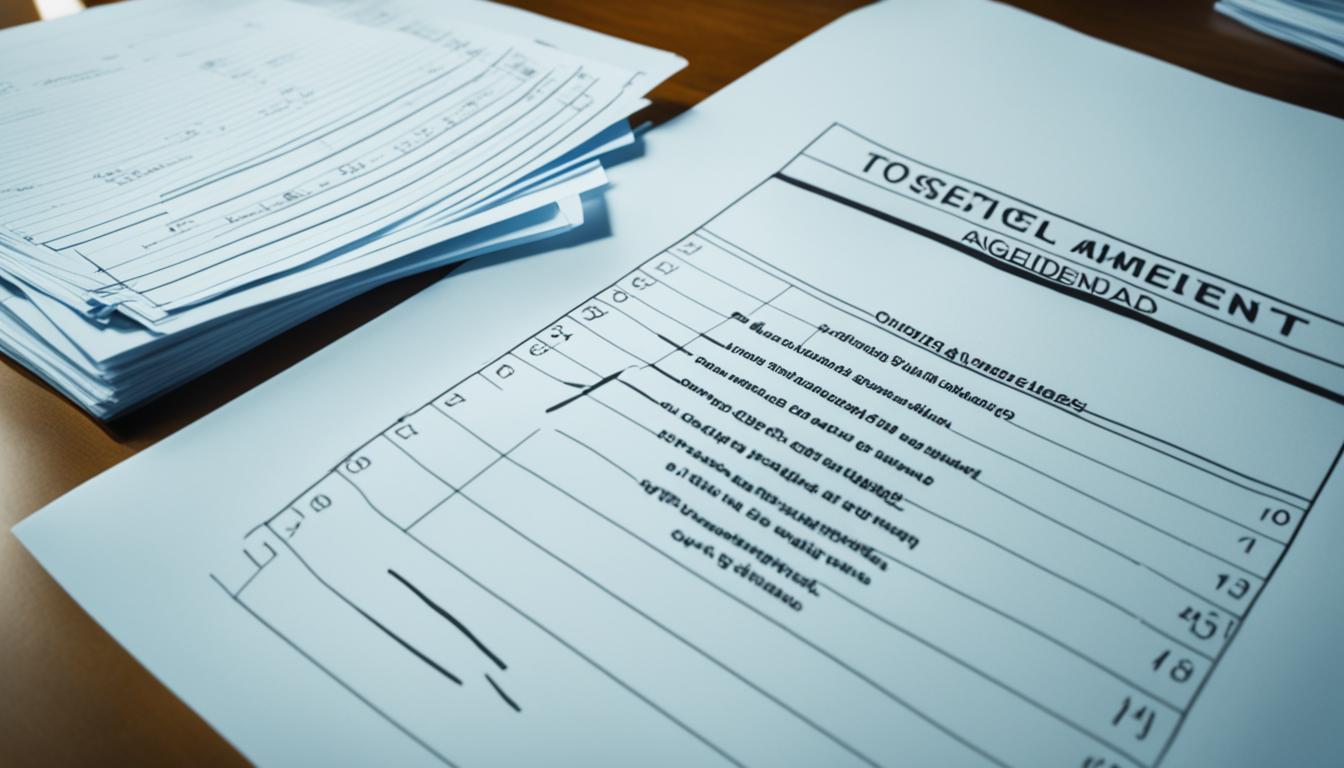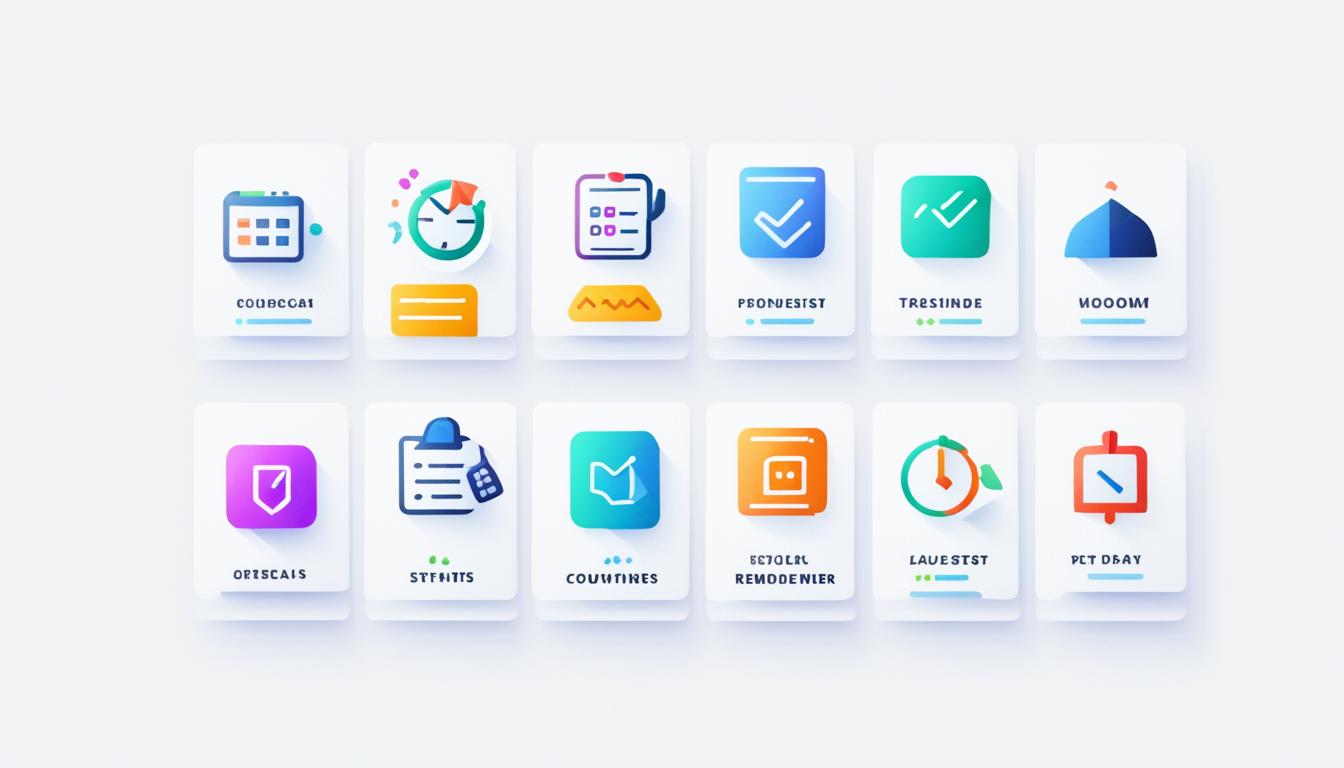
“Prioritizing Your Tasks: A Productivity Platform’s Approach””

“You cannot overestimate the unimportance of practically everything.” – Greg McKeown
Task prioritisation plays a crucial role in enhancing productivity and achieving success in both personal and professional endeavours. As we navigate through our fast-paced lives, it’s easy to get overwhelmed by the sheer volume of tasks and responsibilities. It becomes essential to identify the most important and urgent tasks, enabling us to allocate our time and energy effectively.
A productivity platform offers a comprehensive solution to streamline task management, time management, and organisational tools. It equips you with an array of productivity techniques, enabling you to optimise your workflow and maximise your efficiency.
Key Takeaways:
- Task prioritisation is essential for staying focused and achieving goals.
- A productivity platform provides a range of tools and techniques for effective task management.
- Organising tasks based on their urgency and importance enhances productivity.
- Implementing productivity techniques improves time management skills.
- Task prioritisation allows you to allocate resources efficiently and meet deadlines.
Why is Task Prioritization Important?
Effective task prioritisation is crucial for maximising your efficiency, focus, and time management. By determining the urgency and importance of each task, you can allocate your resources effectively and ensure that you tackle the most important tasks first. This enables you to maintain focus and productivity, instead of being overwhelmed by an unorganised workload.
When you prioritise your tasks, you can:
- Focus your time and energy on high-priority tasks that contribute to your goals and responsibilities.
- Manage your time efficiently by identifying critical tasks that require immediate attention.
- Meet deadlines and avoid last-minute rushes by planning ahead.
- Eliminate unnecessary tasks or those that provide minimal value.
Without effective task prioritisation, you risk wasting time on less important tasks, thereby compromising your overall efficiency. By prioritising your tasks, you can ensure that you make the most of your valuable time and achieve your goals more effectively.
“The essence of effective time management is prioritisation.” – Brian Tracy
Efficiency and Focus
When you prioritise your tasks, you are able to direct your efforts towards meaningful work, resulting in increased efficiency. By focusing on high-priority tasks, you avoid wasting time on less important activities that do not contribute significantly to your larger goals. This enables you to make progress and accomplish more in less time.
Time Management
Task prioritisation is essential for effective time management. By understanding the urgency and importance of each task, you can allocate your time wisely, ensuring that critical tasks are completed on time. This helps you avoid time-consuming interruptions and allows you to plan your schedule more efficiently.
Best Practices for Task Prioritization
When it comes to effectively prioritising your tasks, there are several best practices that can help you improve your time management skills and boost your productivity. By implementing these strategies, you can stay organised, focused, and efficiently manage your workload. Here are the key best practices for task prioritisation:
Making a List of Your Tasks
Start by creating a comprehensive list of all the tasks you need to complete. This will help you gain a clear understanding of the scope of your work and ensure that no tasks are overlooked. Consider using software or a productivity tool to create and manage your task lists, ensuring easy access and the ability to update and prioritize tasks on-the-go.
Knowing the Deadlines
Be aware of the deadlines associated with each task. This will enable you to determine the priority of tasks that have imminent due dates, ensuring that you allocate sufficient time and resources to complete them on time. By having a clear understanding of your deadlines, you can effectively manage your time and avoid last-minute rushes.
Estimating Time and Effort
Before diving into a task, take a moment to estimate the time and effort required to complete it. This estimation will help you allocate your time and resources effectively, ensuring that you don’t spend too much time on low-priority tasks while neglecting critical ones. By accurately assessing the time and effort required, you can plan your schedule accordingly and prevent unnecessary delays.
Determining the Highest-Priority Tasks
Identify the tasks that are of utmost importance and urgency. These are the tasks that directly contribute to your goals or require immediate attention. By focusing on the highest-priority tasks, you can ensure that you make progress towards your objectives and complete critical work in a timely manner.
Completing the Highest-Priority Tasks First
Once you have determined the highest-priority tasks, make them your top priority and complete them first. This approach ensures that you tackle the most significant and time-sensitive tasks when you are fresh and focused. By accomplishing these tasks early on, you can reduce stress, gain momentum, and pave the way for smoother task completion.
Remaining Flexible
Despite your best efforts to prioritize tasks, unexpected events or new priorities may arise. It’s important to remain flexible and adapt to changes in your workload. Review your task list regularly and adjust priorities as needed. Being agile and responsive to shifting priorities will help you maintain productivity and meet changing demands.
Reviewing and Reevaluating Tasks Often
Regularly review and reassess your tasks to ensure that they align with your goals and priorities. As you make progress, deadlines may shift, new tasks may arise, or some tasks may become less relevant. Take the time to evaluate whether certain tasks can be delegated, postponed, or eliminated altogether. This ongoing assessment will help you optimize your task list and focus on what truly matters.
Effective task prioritization involves making informed decisions about how to allocate your time and effort. By following these best practices, you can enhance your time management skills, increase your productivity, and achieve better results.
Implementing best practices for task prioritization is crucial for managing your workload effectively and staying on track with your goals. By making a comprehensive task list, knowing your deadlines, estimating time and effort, determining highest-priority tasks, completing them first, remaining flexible, and reviewing tasks frequently, you can enhance your time management and achieve optimal productivity.
Task Prioritization Techniques
When it comes to effective task prioritization, there are various techniques you can utilize. These techniques provide unique approaches to help you manage your tasks efficiently and boost your productivity. Explore the following task prioritization techniques and choose the one that best suits your working style:
To-Do List
The classic to-do list is a simple yet effective way to prioritize tasks. Create a comprehensive list of all your tasks, allowing you to visualize your workload and determine the order of priority. Tick off completed tasks as you progress, giving you a sense of accomplishment and motivation to move forward.
ABCDE Method
The ABCDE method, popularized by Brian Tracy, involves assigning priorities to each task using letters from A to E. Tasks labeled as A are the highest priority, while E tasks can be eliminated or delegated to others. By categorizing tasks based on their importance, you can focus on what truly matters.
Chunking Technique
The chunking technique involves breaking down larger tasks into smaller, more manageable chunks. By dividing complex tasks into achievable subtasks, you can tackle them one step at a time, reducing overwhelm and increasing efficiency.
1-3-5 Method
The 1-3-5 method encourages you to select a combination of one big task, three medium tasks, and five small tasks to accomplish within a specified timeframe, such as a day or week. This method provides a balanced approach to task prioritization and helps you achieve a sense of progress and accomplishment.
Getting Things Done (GTD) Method
The GTD method, developed by David Allen, emphasizes capturing all your tasks and ideas in an external system and organizing them into actionable items. By systematically capturing, clarifying, organizing, and reviewing tasks, you can prioritize effectively and manage your workload efficiently.
Eat the Frog Strategy
The Eat the Frog strategy, coined by Mark Twain, suggests starting your day by tackling the most challenging task—the “frog.” By completing the most difficult task first, you can kick-start your productivity, gain momentum, and alleviate mental stress.
Two-List Strategy
The two-list strategy involves maintaining two separate lists: one for your long-term goals and the other for your daily tasks. By aligning your daily tasks with your long-term goals, you can ensure that each task contributes towards your overall objectives, keeping you focused and motivated.
Ivy Lee Method
The Ivy Lee method is a simple yet powerful technique that requires identifying the six most important tasks for the following day at the end of each day. Prioritize these tasks in order of importance, and the next day, focus solely on completing these critical tasks. This method promotes clarity, focus, and effective time management.
Experiment with these task prioritization techniques and discover the approach that works best for you. Remember, effective task prioritization is vital for maximizing productivity and achieving your goals.
The Eisenhower Matrix: A Time Management Tool
The Eisenhower Matrix, also known as the Urgent-Important Matrix, is a remarkable time management tool that can significantly enhance your ability to prioritize tasks effectively. This matrix divides tasks into four distinct quadrants, allowing you to categorize them based on their urgency and importance. By utilizing the Eisenhower Matrix, you can focus your efforts on what truly matters and maximize your productivity.
Quadrants of the Eisenhower Matrix
The Eisenhower Matrix consists of four quadrants that assist in organizing tasks:
- Urgent and Important: Tasks falling into this category require immediate attention as they have significant implications for your goals or responsibilities. Prioritize these tasks as they demand your immediate action.
- Non-urgent but Important: These tasks encompass long-term goals, personal growth, and strategic planning. Although they are not urgent, they contribute immensely to your success and well-being. Allocate dedicated time to complete these tasks.
- Urgent but Not Important: Tasks in this quadrant may appear urgent due to external pressures or interruptions, but they do not align with your long-term goals. Delegate or minimize your involvement in these tasks to redirect your focus on more essential matters.
- Not Urgent and Not Important: Tasks falling into this quadrant are often time-wasting activities or distractions. Avoid spending excessive time on these tasks and eliminate them when possible to maximize your productivity.
By combining the principles of task prioritization with the potential of the Eisenhower Matrix, you can streamline your decision-making process, identify critical tasks, and allocate your time and resources efficiently. This invaluable tool empowers you to achieve better time management and enables a more focused and productive approach to task completion.
How to Use the Eisenhower Matrix
To effectively prioritize your tasks and manage your time, you can utilize the Eisenhower Matrix, also known as the Urgent-Important Matrix. This matrix helps you categorize tasks based on their urgency and importance, assisting you in making informed decisions about which tasks to focus on first.
To effectively use the Eisenhower Matrix, follow these steps:
- List all your tasks: Begin by creating a comprehensive list of all the tasks you need to complete.
- Assess urgency and importance: Evaluate each task and determine its level of urgency and importance. Urgency refers to how quickly the task needs to be completed, while importance relates to the impact and significance of the task on your long-term goals.
- Categorize tasks: Place each task into one of the four quadrants of the Eisenhower Matrix based on its urgency and importance:
| Quadrant | Urgent | Not Urgent |
|---|---|---|
| Important | Tasks that are both urgent and important should be prioritized and completed first. | Tasks that are important but not urgent should be scheduled for completion later. |
| Not Important | Tasks that are urgent but not important can be delegated to someone else if possible. | Tasks that are neither urgent nor important should be eliminated or minimized. |
Prioritize tasks within each quadrant: Once you have categorized your tasks, prioritize them within each quadrant based on their specific time constraints and their alignment with your overall goals and objectives.
Execute tasks in order of priority: Start working on the tasks in each quadrant, beginning with the most urgent and important ones. As you complete each task, move on to the next one according to your prioritization.
Regularly review and adjust: Regularly review and adjust your Eisenhower Matrix to ensure that tasks are appropriately categorized and prioritized as circumstances change or new tasks arise. This flexibility allows you to stay on top of your tasks and make efficient use of your time.
The Eisenhower Matrix provides a structured framework for effective task prioritization, offering you a systematic approach to manage your time and increase your productivity.
The Benefits of Time Boxing
Time boxing is a powerful technique that can significantly enhance your task management, productivity, and time allocation. By allocating specific time slots to different tasks or activities, you can create structure and focus in your daily routine. Let’s explore the various benefits of implementing time boxing:
“Time is what we want most, but what we use worst.” – William Penn
Increase Focus and Productivity
When you set specific time boundaries for each task, you create a sense of urgency and concentrate your efforts. This focused approach helps you eliminate distractions and prioritize the completion of important tasks. By working within these set time frames, you can boost your productivity and achieve more in less time.
Prevent Procrastination
One of the challenges many of us face is procrastination. We tend to delay important tasks, leading to stress and reduced productivity. Time boxing helps combat procrastination by breaking down tasks into manageable chunks. With a clear time frame, you are more likely to take action and complete tasks promptly.
Increase Accountability
Time boxing promotes accountability by setting clear deadlines for each task. When you allocate specific time slots, you create a commitment to yourself. This sense of accountability motivates you to stay focused and complete tasks within the allocated time, fostering a sense of achievement and progress.
Better Time Allocation
By using time boxing, you can allocate your time more effectively. You can dedicate more time to complex or high-priority tasks while ensuring that other important tasks also receive attention. This balanced approach to time allocation allows you to make the most of your available time and achieve a greater sense of accomplishment.
Promote Work-Life Balance
Time boxing helps you strike a balance between work and personal life. By allocating specific time slots for work tasks, you create dedicated periods for relaxation, hobbies, family, and self-care. This intentional division between work and personal time helps prevent burnout and promotes a healthier work-life balance.
Implementing time boxing as part of your task management strategy can revolutionize your approach to productivity. By increasing focus, preventing procrastination, promoting accountability, improving time allocation, and fostering work-life balance, time boxing empowers you to make the most of your valuable time.
With all its benefits, it’s clear that time boxing is an effective technique for achieving optimal task management and productivity. Take control of your time and prioritize your tasks effectively with time boxing.
Brain Dump and Task Organization
The brain dump method is a highly effective technique for managing and organizing your to-do list. It involves emptying your mind and transferring all your thoughts, tasks, and ideas onto paper or a digital document. By doing this, you can declutter your mind and gain a clearer perspective on what needs to be done.
Once you have completed the brain dump, it’s essential to prioritize the tasks to ensure optimal task organization and improve productivity. One effective way to prioritize tasks is by using the 80/20 rule and the Pareto Principle.
“The 80/20 rule suggests that 20% of your tasks will generate 80% of the results. The Pareto Principle helps you identify the most important and impactful tasks from your brain dump.”
Review the tasks from your brain dump and identify the ones that align with the 80/20 rule. These are the tasks that will have the greatest impact on your productivity and help you achieve your goals. Prioritize these tasks and allocate your time and resources accordingly.
| Benefits of Task Organization | Importance |
|---|---|
| Clear roadmap for accomplishing tasks | Ensures efficient use of time and resources |
| Reduces stress and overwhelm | Improves focus and concentration |
| Helps prioritize tasks based on importance and urgency | Promotes effective decision-making |
| Enables effective collaboration and delegation | Enhances teamwork and productivity |
By utilizing the brain dump method and applying effective task organization techniques, you can optimize your to-do list and streamline your workflow. This will enable you to approach your tasks with clarity and focus, resulting in increased productivity and a greater sense of accomplishment.
The Pomodoro Technique for Time Management
The Pomodoro Technique is a time management method that can greatly improve your productivity and task prioritization. This technique involves breaking your work into manageable 25-minute intervals called “Pomodoros,” followed by short breaks.
By working intensely for a focused period of time and then taking regular breaks, you can enhance your ability to concentrate and complete tasks efficiently.
Implementing the Pomodoro Technique allows you to optimize your time and work smarter, not harder. Here’s how it works:
- Choose a task you want to work on.
- Set a timer for 25 minutes and start working on the task.
- Focus solely on the task during this 25-minute period until the timer goes off.
- When the timer rings, take a short 5-minute break.
- After the break, start another 25-minute Pomodoro and continue working on the task.
- Repeat this cycle of focused work and short breaks until you complete four Pomodoros.
- After completing four Pomodoros, take a longer break of around 15-30 minutes to rest and recharge.
This technique helps improve your time management by dividing your work into small, manageable chunks, ensuring you stay focused and motivated. By completing tasks in short bursts with scheduled breaks, you can maintain a high level of productivity without burning out.
Furthermore, the Pomodoro Technique enhances your ability to prioritize tasks effectively. By allocating fixed time intervals for each task, you can identify the most important and urgent tasks that require your immediate attention.
Implementing the Pomodoro Technique not only increases your efficiency but also helps you develop better time management habits. With consistent practice, you can improve your task prioritization, reduce distractions, and achieve better work-life balance.
The Pomodoro Technique is a highly effective method for boosting your productivity and mastering the art of time management. By incorporating this technique into your daily routine, you can make significant progress on your tasks while maintaining focus and motivation.
The Focus Funnel: Optimizing Tasks for Efficiency
When it comes to managing your tasks and maximizing productivity, the focus funnel is a valuable strategic framework. This approach aims to narrow your focus by filtering out distractions and prioritizing key activities, allowing you to optimize your tasks and increase efficiency.
The first step in implementing the focus funnel is to identify tasks that can be eliminated, automated, or delegated to others. By removing non-essential tasks, automating repetitive processes, and delegating tasks that can be handled by someone else, you can free up valuable time and resources. This enables you to direct your energy towards the tasks that truly matter and require your attention.
In the process of task elimination, it is essential to assess which tasks are unnecessary or low priority. By eliminating these tasks, you can declutter your workload and create space for more important activities. This allows you to streamline your focus and allocate your time and efforts more effectively.
Task automation is another key aspect of the focus funnel. By automating repetitive or routine tasks, you can save time and reduce the risk of errors. This can be achieved through the use of technology, such as workflow management tools or task automation software. By leveraging these tools, you can streamline your workflow and focus on tasks that require human intervention and decision-making.
Delegating tasks to others is an effective way to optimize your workload. Identify tasks that can be assigned to colleagues or team members who have the necessary skills and expertise. Delegation not only lightens your workload but also enables others to develop their skills and contribute to the overall efficiency of the team or organization.
The focus funnel provides a structured approach to task optimization, allowing you to maximize your productivity and achieve your goals more efficiently. By eliminating, automating, and delegating tasks, you can streamline your focus and allocate your time and resources strategically.
| Task Optimization Methods | Description and Benefits |
|---|---|
| Task Elimination | Identify and remove unnecessary or low-priority tasks, freeing up time and mental energy. |
| Task Automation | Automate repetitive or routine tasks to save time, reduce errors, and improve efficiency. |
| Task Delegation | Assign tasks to others with the necessary skills and expertise, reducing workload and fostering team collaboration. |
Implementing the focus funnel not only optimizes your tasks but also allows you to maintain focus on the activities that truly drive results. By effectively prioritizing and managing your tasks, you can enhance your productivity and achieve better outcomes in your personal and professional life.
The Time Box Experiment
Implementing effective task prioritization and management techniques is crucial for boosting productivity. One such technique that can significantly enhance your productivity is the time box experiment. By experimenting with different time boxing techniques, you can discover the approach that works best for you and helps you achieve optimal task prioritization and completion.
The time box experiment involves setting specific time slots, or “time boxes,” for different tasks or activities. During each time box, you focus solely on the designated task, dedicating all your efforts and attention to its completion. This technique helps you manage your time more effectively, preventing distractions and increasing your overall productivity.
When conducting a time box experiment, it’s essential to try out different time durations for your time boxes. Some individuals find shorter time boxes, such as 25 minutes, known as the Pomodoro Technique, to be most effective for maintaining focus and productivity. Others may prefer longer time boxes, such as 60 minutes, which allow for deeper immersion in tasks.
Experimenting with various time boxing techniques enables you to determine the most suitable duration for your tasks and personal work style. You can also explore different ways to structure your time boxes, such as alternating between intense work and short breaks or incorporating timed intervals for specific activities.
By conducting a time box experiment, you can gain valuable insights into your personal productivity patterns and preferences, empowering you to optimize your task prioritization and management. This experiment helps you identify the most efficient methods for dividing and allocating your time, ensuring that you make consistent progress on your tasks and achieve your goals.
To give you a better understanding, below is an example of the results of a time box experiment:
| Time Box Duration | Productivity Level |
|---|---|
| 25 minutes (Pomodoro Technique) | High |
| 60 minutes | Medium |
| 90 minutes | Low |
Based on this example, it’s evident that the participant achieved the highest level of productivity during 25-minute time boxes using the Pomodoro Technique. This information allows them to optimize their task prioritization by allocating shorter time boxes for tasks that require intense concentration and focus.
Remember, the time box experiment is a personal journey that requires adaptation to your unique work habits and preferences. Keep experimenting with different time boxes and techniques until you find the perfect formula that maximizes your productivity and task management.
Now that you have a deeper understanding of the time box experiment and its potential benefits, let’s explore the key takeaways and insights in the next section.

Conclusion
Prioritizing your tasks is crucial for enhancing productivity, effective time management, and maintaining organized workflows. By incorporating various techniques such as the Eisenhower Matrix, time boxing, and prioritization strategies into your task management system, you can efficiently manage your workload and optimize your overall efficiency. Experimenting with different methods will enable you to identify the approach that resonates with you best, enabling you to prioritize tasks effectively and achieve your goals.
Implementing these strategies will empower you to stay focused, organized, and productive. The Eisenhower Matrix aids in categorizing tasks based on urgency and importance, ensuring that you allocate your resources appropriately. Time boxing enables you to allocate specific time slots to different tasks, boosting your focus and productivity. By utilizing prioritization techniques, you can determine the optimal order of tasks, ensuring that you tackle the most critical ones first.
Remember, effective task prioritization is not a one-size-fits-all solution. It may require some trial and error to find the techniques that work best for you. By committing to refining your approach, you can cultivate a system that aligns with your unique needs and preferences. Incorporate these strategies into your daily routine to optimize task prioritization, boost your productivity levels, and unlock your full potential.






























